P&O Cruises
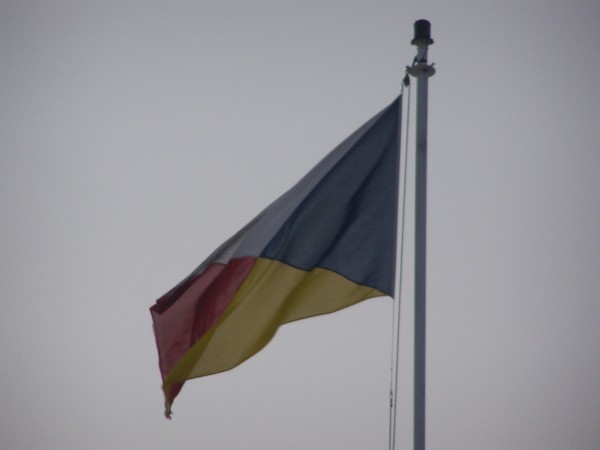
The P&O flag as we know today. The colours of the flag are explained when you look at their first services to Spain and Portugal. Of course the 'Peninsular' part of the name is based on the Iberian Peninsula, and the flags of both states there were incorporated in the flag. The red and yellow of Spain, that they still use today, and the blue and white of Portugal. Of course, the Portugese flag nowadays is green and red, but this is only since 1910. From 1830 and 1910, the time from which P&O originates, blue and white were the main colours.
The P&O Line is one of the oldest passenger-shipping companies in the world, founded in 1835 by Brodie Willcox and Arthur Anderson. Anderson, an inhibitant of the Shetland Islands, had been in the Navy before and came back in Plymouth when he finished his duties. Because he had no money, he walked back to London and was taken care of by shipbroker Willcox. They were in the shipowning business from 1825 onwards and found a very exciting way of making money with a wrecked American schooner they rebuilt after she almost foundered on the rocks near Dover. They put her in service between the South of England and Portugal, and with the contacts Anderson gained there, they started a lucrative but very illegal trade in arms for the new Portugese Navy, that was set up by a retired English Naval officer who was now nicknamed Mad Charlie. His normal name had been Sir Charles Napier, not to be confused with the shipbuilder from Scotland, though. In Portugal he was known as Carlo De Fonza. Because of the illegal nature of the early P&O, then not yet under that name, though, Anderson also gave himself another name, the rather predictable Mr Smith. So the company now known as P&O Cruises originates from these illegal transports in the mid 19th century, something that is luckily overlooked now...
Its seems ages that Victoria was sailing for P&O between 1995 and 2002. Here she is seen at Amsterdam in the spring of her last year with the line. Afterwards, she became Mona Lisa and a link to her page is given and the end of this page.
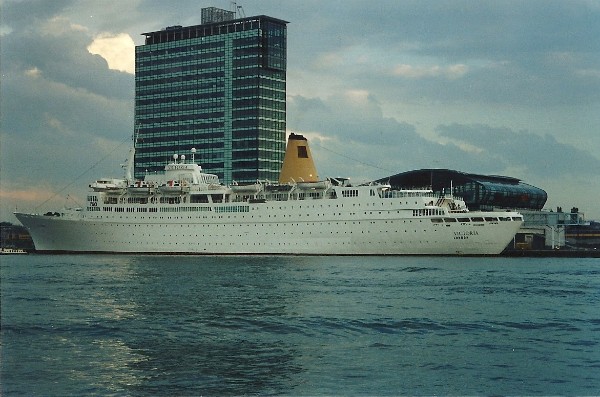
Within these years, something of a fleet was built up and Willcox and Anderson also offered passengertrips aboard their ships. In the form of a fake-advertisement, to fill some empty space in the first edition of his Shetland Journal that came out in 1835, Anderson published about a non-exsisiting ship that was said to explore the wild coast of Scotland, the Faroer Islands and Iceland. Like the ship, the journey did not exsist, and the idea of just travelling at sea for fun was of course ridiculous. Later on, this fake-advertisement and the brainchild of Arthur Anderson, was regarded as the first idea of a cruise. In the same year, Willcox and Anderson set up a true steamline between Falmouth and Portugal and the South of Spain, trading as the Peninsular Steam Company. The company soon grew into more parts of the Mediterranean and after that, also from Suez to India and Australia, changing the name of the company to Peninsular & Oriental Steam & Navigation Company in the early 1840's. From 1844 onwards, P&O started to offer pleasure-voyages in the Mediterranean, so the advertisement of Anderson from 1835 now became sort of reality. These voyages were not cruises like we know now, it was more a combination of several line-voyages and so a cruise was undertaken at several ships, with several long waiting times in the ports. But in these ports, excursions were offered to ease those waiting times and to explore the Orient. These were the first cruises anywhere in the world and that is something P&O is widely recognized for. In its heyday the company had become one of the biggest in the world and surely the biggest company in Great Britain, easily surpassing the Cunard Line. This was of course certainly the case, after P&O took over the name and fleet of the British India Company, that had been the largest British shippingline untill the merger of the two in 1914. BI added 137 ships to the fleet of P&O's 70. This was not the only take-over P&O did, by the way. Before the merger between P&O and BI, the company had taken over the fleet of emigrantliners from the Blue Anchor Line, that ran a secundary service from Britain via the Cape of Good Hope to Australia. During the first worldwar, P&O also took over the fleets of the New Zealand Shipping Company, the Federal Steam Navigation Company, Union Steamship Company of New Zealand, Hain Steamship Company and James Nourse Ltd. All of these companies together added some 107 ships to the now called P&O Group, together with of course all of their trading route's, mainly in the Far East and the Pacific Ocean. The ships of the P&O Group were the true lifeline between Great Britain and its colonies overseas in India, Africa and Australia. In 1918, there were rumours that P&O was going to buy Cunard Line and these rumours were widespread. P&O denied, but it would have been a possibility. Instead the Orient Line was bought by P&O in that same year, next to the Khedieval Mail Line. In 1920, General Steam Navigation Company was bought, followed by the Strick Line in 1923. After that, the fleet of the P&O Group numbered around 500 ships. It is often said that without P&O, the great British Empire could never have exsisted and their flag, pictured above this text, is one of the most well-known flags of all shipping lines. Compared to the P&O Group in those days, Carnival Corporation is just a small bunch of shippinglines, including the remains of this once mighty P&O fleet of course...

The new Oriana, entering the port of Amsterdam for the first time at the 30th of august 1997. She was my introduction to cruiseship photography on this very rainy day.
P&O always did things differently. They never had any Captains, that's for sure. With P&O, their possition was called Commander, and it still is. Also P&O never had a Board of Directors but a Court of Directors Shareholders were called Proprietors and the company never had any shares, those were called stock. The Court of Directors always adressed to the Proprietors with terms as 'your' fleet and 'your' ships, showing that those who held stock were truly owners in their own right.
But of course the downslide of the passengershipping lines in the 1960's and 1970's could have easily ended the great company if it hadn't grew the way P&O did. They entered a lot of different businesses like oil-rigs, containerports, housing and ferries. Although the Indian and Australian lines were still longer profitable then the lines at the North and South Atlantic, the last P&O passengersailing as line-voyage was taken in 1974 by the British India ship Kenya. P&O had just before bought Princess Cruises from its founder Stanley B. MacDonald and continued cruising under P&O name only with their two biggest ships, Oriana (I) and Canberra. When Oriana (I) was sold to Asia as a hotelship, Canberra was the only passengership under P&O-name.
The new P&O Cruises golden sun logo is added to the sides of the newest ships. Here, the logo featured on Azura is shown.
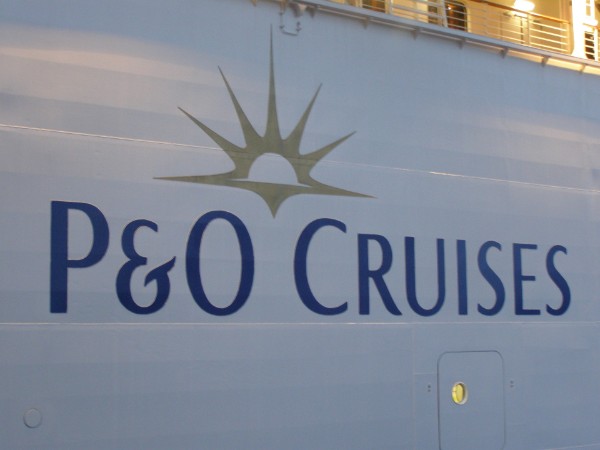
In 1988, P&O was starting to try and get a little more of the cruisebusiness themselves. P&O Cruises was created and the basics for the company as we know today were laid out. Sea Princess (I) was renamed Victoria and was swiched from Princess Cruises to P&O in 1995, although she was basicly already used as P&O Cruises ship in her last years sailing for Princess. P&O were looking for a running mate and later replacement ship of the aging (but still popular) Canberra and this new ship became the first newbuilt cruiseliner for P&O. In 1972, P&O had added the Spirit Of London to their cruising fleet, but originally, she had not been an order for P&O but for Norwegian Caribbean Lines. Next to that, in 1974 already she was replaced in the fleet of Princess Cruises, that was really P&O's cruising fleet next to the declining liners of P&O itself. The first new ship became the instantly succesfull Oriana (II). She was followed by her near sister Aurora in 2000. In 2003, P&O Princess Cruises, the cruisedivision of the company, demerged from the main P&O Group, that was reduced to an investment company, mostly in containerports throughout the world. In march 2006, the company P&O was absorbed into a merger with Dubai Ports International, creating one of the biggest owners of port-infrastructure and real-estate in the world. Sadly, this also marked the end of the name P&O as such, because the company was renamed as DP World, controlled from the wealthy Dubai desert. This move also caused a stirr in the US, because now several US ports that were formally controlled by P&O, were now partially under Arab control. In the aftermath of the attacks of september 11th, 2001, this was not really favourable for the Bush-administration and the company was forced to sell it's US interests to other parties.
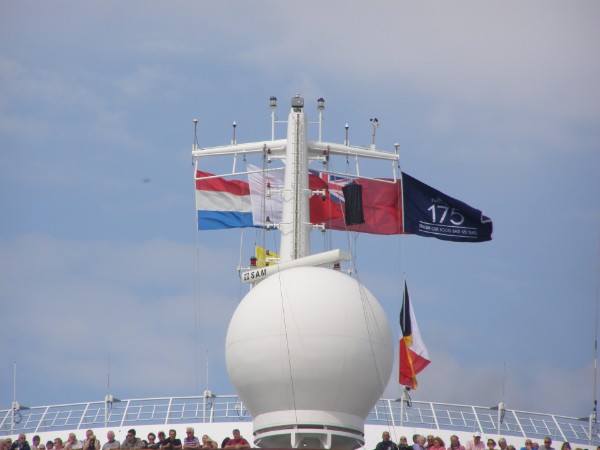
The cruisedivision was registered on it's own at the London Stock Exchange and after a much debated failure of a merger with Royal Caribbean International, it was snapped up by Carnival Corporation in 2003. This move made Carnival Corporation still more the leader in the cruise-industry. P&O Cruises and Princess Cruises were now seen as two different lines, and the P&O sign was no longer a part of the Princess ships. But Carnival Corporation did not stop expanding the line with even larger ships, where mostly P&O and Princess were splitting orders.
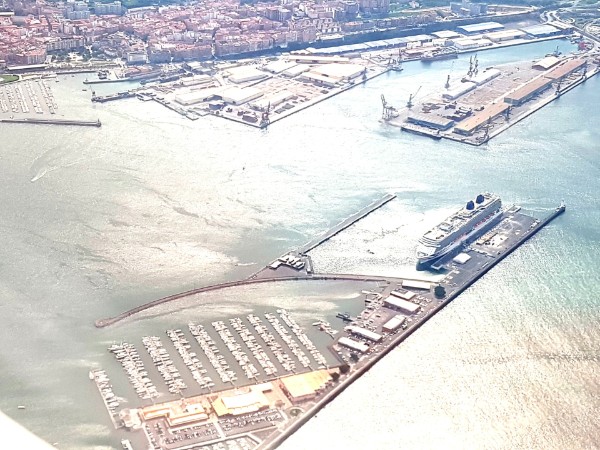
Certainly a very different angle then normal for this site shows P&O's newest and largest ship Britannia, docked at the port of Algorta (Bilbao) in the Basque Coutry. This picture was made and sent to me by Ilona van Zanten at the 5th of may, 2016.
P&O added the 116.000 ton sisters Ventura and Azura to the fleet. Now, the new P&O Cruises has rebuilt their once mightly fleet up to 7 ships and a new dawning has started for the old company. To celebrate their 175th year of operation, a special event was organized at Southampton at the 3rd of july 2012 when all seven ships were present at this port. A sight never seen in cruising history, the fleet of one of the mightiest companies all together. For the event, a special flag was created, seen above carried by the great Oriana when she sailed into IJmuiden the day after. A new milestone came in 2014, when the Britannia was added to the fleet, a ship measuring at over 140.000 tons, making it with ease the largest ship that was ever in P&O service. Next to her introduction, the P&O ships also all recieved a new livery, losing the yellow funnels and all white ships that has been the P&O livery since the 'Strath'-liners from the 1930's. From now on, the funnels are deep-blue with the golden sun logo and on the bows of the ships, an artist impression of the Union Jack is printed to show the line's 'British heritage'. This is done, to make the ships more recognizable. Opinions about this still are very varied...
In 2019, to the sadness of many, P&O waved the Oriana of 1995 goodbye as she was considered too old for the line, that was really shifting towards a more mainstream style after the Carnival take-over. One year later, the company recieved again a monstrously large replacement under the name Iona, this time a ship of over 180.000-tons. With ease the largest ship ever constructed for the British market. Within a few years, a yet unnamed sistership will join her.
Aurora showing her Union Jacked bow in january 2015.
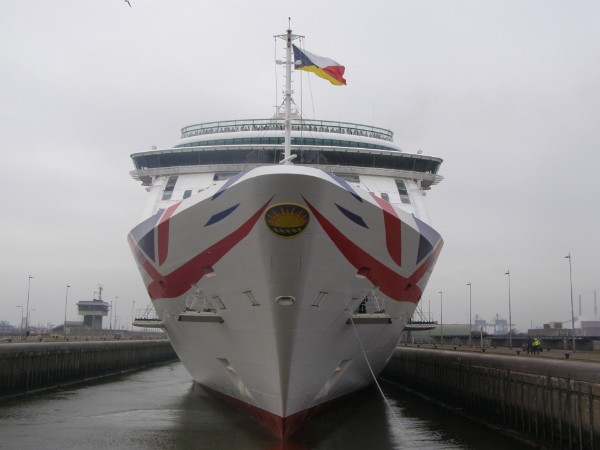
P&O Australia
After P&O took over the long established Sitmar Line in 1988, most of the ships of this company, mainly the three newbuildings, were added to the fleet of Princess Cruises. Only one ship remained in Australian waters, the 1955-built Fairstar. Originally, she was a Bibby Line troopship named Oxfordshire, a sister to British India's Nevasa. Co-incidentally, BI was a subsidiary of P&O at that time. Faistar was not renamed by her new owners and for her, a seperate office was established in Sydney as well as a different funnellogo, other then that of P&O or Princess Cruises. She basicly was the start of the Australian P&O-branch. Also Dawn Princess, the former Fairwind was sailing in Australia, but she was managed as a ship for Princess Cruises. This ship had been built for Cunard Line in 1956 as Sylvania and sailed in Australia untill 1992 when she was sold to the Vlasov Group, the former owners of Sitmar Line. They chartered her out for use by the German company Phoenix Reisen, becoming their first Albatros. In early 1997, because of mechanical issues mostly, Fairstar was sold for scrap and replaced by her old fleetmate Fairsea, one of the ships that had been placed in the Princess fleet as Fair Princess after the Sitmar-deal. This ship had been built as Carinthia for Cunard Line and made her Maiden Voyage in june 1956, one year earlier then the Maiden Voyage of the Fairstar that she now replaced. Being an older vessel, she kept the classic atmosphere from the beloved Fairstar and of course, although a Princess name now, still a Fair one. The Australian office was kept for this 'new' ship so she did not have much to do with those other Princess ships and the seperate Australian brand was continued with her.
In 2000, Fair Princess was herself replaced and sold off to China as a casinoship. This was also the year where-in P&O Princess, the cruise operations from the P&O Group, demerged from the main company. The Australian branch was now renamed under its own banner, which it never had before, as P&O Australia. The first ship for this banner was another former Sitmar ship, the 1984-built Fairsky. Between 1988 and 2000, she had been sailing for Princess Cruises also as their Sky Princess. For P&O Australia, she started a new namingsystem as Pacific Sky. In 2003, P&O Princess was about to merge with Royal Caribbean International, but finally picked up by Carnival Corporation when this deal collapsed. It was a huge addition to the Corporation's fleet, including P&O, P&O Australia, Princess Cruises, Seetours (which was an owning name for the ships of AIDA Cruises and A'rosa Cruises) and Ocean Village. Because of this move, investments seemed appropriate. Indeed, in 2004, the former 1985-built Jubilee of Carnival was added to the Australian fleet as Pacific Sun, so for the first time the line had two ships operating.
Pacific Pearl visited Amsterdam in 2002 as Arcadia. She will now soon be sailing for CMV Cruises as Columbus. This ship was the last ship launched for Sitmar Cruises and when she was launched in 1988, she was named Sitmar FairMajesty. For her, a new funnellogo and livery was designed, but this new livery only went to sea in the Sitmar FairWind between june 1987 and the sale to P&O on the 28th of july 1988. Sitmar FairMajesty started sailing as Star Princess for Princess Cruises from march 1989 instead.
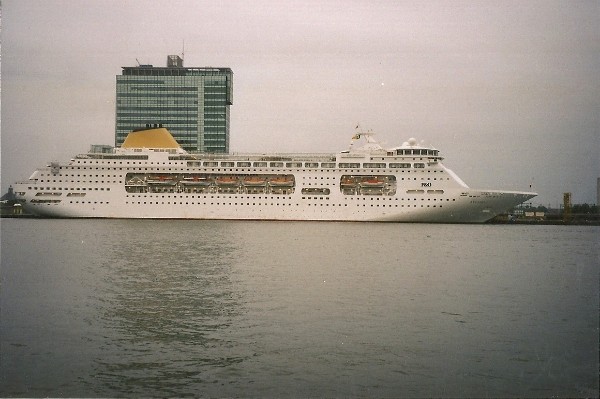
Another ship came over to Australia as in 2005 the 1980-built former Carnival ship Tropicale was added as Pacific Star, but then one year later the Pacific Sky left the fleet. As the last steamship ever built for a cruisecompany, she had become too outdated. But with no former links anymore to the style of Sitmar Cruises and the replacing ships being older ones themselves, Australians were becoming aware of the fact that P&O Australia was a company mainly used to replace older tonnage instead of recieving modern liners. Three again former Sitmar ships entered the next years, but also those were built or designed in the late 1980's and the beginning of the 1990's, now some two decades old. It was a nice touch though that three of the former Sitmar-designed vessels were operating in Australia together, the Pacific Pearl that had been launched in 1988 as Sitmar FairMajesty and the duo Pacific Dawn and Pacific Jewel that had been designed just before the P&O deal and had entered service for Princess Cruises after the take-over of Sitmar as Regal Princess (1990) and Crown Princess (1989). Being larger and more modern, they were a sign of commitment from Carnival to the Australian market, although not everybody down under was pleased by their older age.
In 2015, the company recieved two former Holland America liners, Statendam had become Pacific Eden and Ryndam the Pacific Aria, but those ships have a totally different style and even their hulls were not repainted, so that the livery of P&O Australia became a bunch of different colours and funnellogo's. Although growing with larger and more ships, the company is the only one within Carnival's portfolio that is not immidiately recognizable with one distict style and look.
In 2016, it was announced that the second Dawn Princess, built in 1997, was moving over to the fleet in early 2017, replacing Pacific Pearl that had been sold to CMV Cruises as Columbus. But more exciting was the news that a 133.500-ton ship was going to be built for P&O Australia for service from 2019 onwards. Seemingly, the time was finally ripe to have a new ship in the Australian market as the growing number of ships in the P&O Australia fleet has suggested in the years before. But in the end of the same year, this excitement was thrown aside when Carnival stated that this ship was instead transferred to Carnival itself. Instead, the 2007-built 113.000-ton Carnival Splendor was now planned to move over to the Australian fleet from 2019 onwards. Again a large improvement to the ships already sailing, but also again a disappointment for many Australians who again were not recieving a newly built ship. In february of 2018 the sceme was again changed and the announcement was made that the 2001-built Golden Princess of Princess Cruises was going to Australia instead. I can imagine how pleased Aussies were when Royal Caribbean assigned their new and splendidly modern 170.000-ton Ovation Of The Seas of 2016 to sail a series of cruises based out of Sydney in addition to its Chinese itineraries. Time will tell who of them will have the best cards for the future of Australian cruising.
Former ships
Since every P&O liner that was added to the fleet since 1995 have sailed before my camera, the company always has a special place for me. Also their history, spanning every aspect of commercial shipping, linertrade and cruising adds to this. Of course they were the first company to really advertise cruising and there are so many interesting stories to tell about the old and new ships. A few ships that have been sailing or are now sailing for P&O Cruises have been placed under different companies on castlesoftheseas. Underneath, I will give links to their pages
Victoria (1995-2002) is placed as Mona Lisa under Princess Cruises
Arcadia (III) (1997-2003) is placed under CMV Cruises as Columbus
Adonia (I) (2003-2005) is placed under Princess Cruises as Sea Princess
Artemis (2005-2010) is placed under Phoenix Reisen as Artania
Adonia (II) (2011-2016) is placed under Princess Cruises as Royal Princess (II)
Adonia (II) (2017-onwards) is placed under Princess Cruises as Royal Princess (II)
For P&O Australia:
Pacific Dawn (2007-now) is placed under Princess Cruises as Regal Princess (I)
Pacific Jewel (2009-2018) is placed under Princess Cruises as Crown Princess (I)
Pacific Pearl (2010-2017) is placed under CMV Cruises as Columbus
Pacific Eden (2015-2019) is placed under CMV Cruises as Vasco da Gama
Pacific Aria (2015-now) is placed under Holland America Line as Ryndam (III)
NOTE: For several facts within this text, I used the information in a book by David Howarth and Stephen Howarth 'The Story Of P&O' (Weidenfeld & Nicolsen, 1994).

